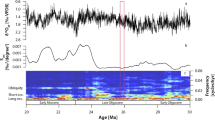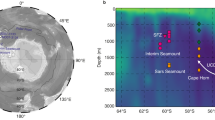Abstract
Two theories of glaciation have received considerable attention, the Milankovitch orbital theory1,2 in which climatic change is ascribed to latitude-dependent variations in solar radiation that accompany changes in the Earth's orbital parameters, and the Antarctic surge hypothesis3–6, in which a large Antarctic ice sheet ‘surges’ into the Southern Ocean thereby increasing the Earth's albedo, and the resultant cooling triggers the growth of ice in the Northern Hemisphere. The interval which encompasses the peaks of the last interglacial maximum at ∼125 kyr (ref. 7) and its subsequent decline, with cooling of the North Atlantic8 and rapid fall of sea level9,10, presumably also includes the event that triggered the succeeding ice age. The raised coral reefs of Huon Peninsula, Papua New Guinea, contain a particularly good record of the interval 140–105 kyr (ref. 11), from which we present oxygen isotope and sea-level data which seem to require an Antarctic surge at 120 kyr, and which also have a bearing on the role of the Milankovitch factor.
This is a preview of subscription content, access via your institution
Access options
Subscribe to this journal
Receive 51 print issues and online access
$199.00 per year
only $3.90 per issue
Buy this article
- Purchase on Springer Link
- Instant access to full article PDF
Prices may be subject to local taxes which are calculated during checkout
Similar content being viewed by others
References
Broecker, W. S. & van Donk, J. Rev. Geophys. Space Phys. 8, 169–198 (1970).
Hays, J. D., Imbrie, J. & Shackleton, N. J. Science 194, 1121–1132 (1976).
Wilson, A. T. Nature 201, 147–149 (1964).
Flohn, H. Quat. Res. 4, 385–404 (1974).
Mercer, J. H. Int. Ass. Sci. Hydrol. Publ. 79, 217–225 (1968).
Mercer, J. H. Nature 271, 321–325 (1978).
Shackleton, N. J. & Matthews, R. K. Nature 268, 618–620 (1977).
Sancetta, C., Imbrie, J., Kipp, N. G., McIntyre, A. & Ruddiman, W. F. Quat. Res. 2, 363–367 (1972).
Chappell, J. & Veeh, H. H. Bull. geol. Soc. Am. 89, 356–368 (1978).
Chappell, J. & Thom, B. G. Nature 272, 809–810 (1978).
Chappell, J. Bull. geol. Soc. Am. 85, 553–570 (1974).
Veeh, H. H. & Chappell, J. Science 167, 862–865 (1970).
Bloom, A. L., Broecker, W. S., Chappell, J. M. A., Matthews, R. K. & Mesolella, K. J. Quat. Res. 4, 185–205 (1974).
Ku, R. L., Kimmel, M. A., Easton, W. H. & O'Neil, T. J. Science 183, 959–962 (1974).
Mesolella, K. J., Matthews, R. K., Broecker, W. S. & Thurber, D. L. J. Geol. 77, 250–274 (1969).
Chappell, J. & Polach, H. A. Bull. geol. Soc. Am. 87, 235–240 (1976).
Chappell, J. & Polach, H. A. Quat. Res. 2, 244–252 (1972).
Weber, J. N. & Woodhead, P. M. J. Chem. Geol. 6, 93–117 (1970).
Land, L. S., Lang, J. C. & Barnes, D. J. Mar. Biol. 33, 221–233 (1975).
Epstein, S., Buchsbaum, R., Lowenstam, H. A. & Urey, H. C. Bull. geol. Soc. Am. 64, 1315–1326 (1953).
Friedman, I. & O'Neil, J. R. Prof. Pap. U.S. geol. Surv. 440-KK (1977).
Aharon, P. thesis, Australian National Univ. (in preparation).
Weber, J. N., Deines, P., Weber, P. H. & Baker, P. A. Geochim. cosmochim. Acta 40, 31–39 (1976).
McCrea, J. M. J. Chem. Phys. 18, 849–847 (1950).
Aharon, P., Compston, W. & Coles, J. N. A.N.Z.S.M.S. 5th Conf. 24 (1978).
Mook, W. G. & Vogel, J. C. Science 159, 874–875 (1968).
Emrich, K., Ehhalt, D. H. & Vogel, J. C. Earth planet. Sci. Lett. 8, 363–371 (1970).
Shackleton, N. J. & Opdyke, N. D. Quat. Res. 3, 39–55 (1973).
Chappell, J. in Climatic Change and Variability—A Southern Perspective (eds Pittock, A. B., Frakes, L. A., Jenssen, D., Petersen, J. A. & Zillman, J.) 211–225 (Cambridge University Press, 1978).
Berger, A. L. Quat. Res. 9, 139–167 (1978).
Author information
Authors and Affiliations
Rights and permissions
About this article
Cite this article
Aharon, P., Chappell, J. & Compston, W. Stable isotope and sea-level data from New Guinea supports Antarctic ice-surge theory of ice ages. Nature 283, 649–651 (1980). https://doi.org/10.1038/283649a0
Received:
Accepted:
Issue Date:
DOI: https://doi.org/10.1038/283649a0
This article is cited by
-
Oxygen isotope temperature calibrations for modern Tridacna shells in western Pacific
Coral Reefs (2022)
-
A biomineralization study of the Indo-Pacific giant clam Tridacna gigas
Coral Reefs (2017)
-
Higher sea surface temperature in the northern South China Sea during the natural warm periods of late Holocene than recent decades
Chinese Science Bulletin (2014)
-
The tropical giant clam Hippopus hippopus shell, a new archive of environmental conditions as revealed by sclerochronological and δ18O profiles
Coral Reefs (2009)
-
Comment on White et al. (1998) “Bahamian coral reefs yield evidence of a brief sea-level lowstand during the last interglacial”
Carbonates and Evaporites (1998)
Comments
By submitting a comment you agree to abide by our Terms and Community Guidelines. If you find something abusive or that does not comply with our terms or guidelines please flag it as inappropriate.



